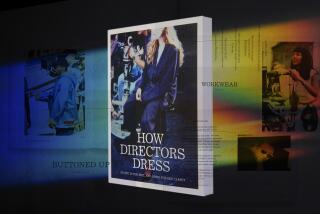A Sartorial Short Cut That Many Men Find Long on Comfort
- Share via
Shorts are not complicated. They require no ironing. They complement nearly every T-shirt in a man’s wardrobe. And some styles feature a ventilated liner, which eliminates the bother of underwear.
What more could a guy want?
“Functionally comfortable” is how Malcolm Wilson puts it.
The Capistrano Beach artist counts himself among a common breed: men who love to wear shorts. Five, six days a week in summer or winter. Bermudas, hiking shorts, jams. Wilson prefers baggy flannels.
Such men crave sartorial brevity after work, on weekends and on Friday nights when their significant others wish they would dress up for a change.
The simplicity of the garment no doubt appeals to male sensibilities. When it comes to men and fashion, the fewer buttons, the better. But a more powerful force must fuel what, for some, amounts to dependency. A subconscious insistence, a primal machismo perhaps, tints Wilson’s voice when he speaks for all shorts lovers:
“I just gotta let my legs breathe.”
This sentiment rings familiar, typically male and typically Californian, an archetype that wraps every Beach Boys album and most Frankie Avalon films into a tidy, sun-drenched package. Think about it. The only time you saw Malibu Ken wear long pants was when he had to take Barbie to the prom.
Here, in the depths of the Golden State, in the bluster of winter’s 60-degree afternoons, Harley riders cruise Hollywood Boulevard in denim cutoffs. Sure, they might be cold. But they will not admit it. Meanwhile, the young guys at Culver City Ice Arena skate circles in their jams.
“I see them every day,” says the manager, who assures us that skating bare-kneed is no problem “unless you fall.”
Certainly there are other risks. The risk of exposing knock-knees, scrawny calves and lumpy ankles. Some dare to uncover wide expanses of pale skin. Not that there is anything wrong with pale skin. Some of my best friends are pale. It’s just not the physical attribute they should be accentuating.
“Whenever I shop for a pair of shorts, I end up in line behind some geek who shouldn’t be wearing shorts at all,” says Keith Heerdt of Canyon Country. “I’ll ask myself, ‘Should I be wearing them?’ ”
Inevitably, he says, the answer is a brazen “yes.”
In the 1959 tome “The Importance of Wearing Clothes,” Lawrence Langner suggests that people use clothes to convey a message about who they are or would like to be. Even the guy in the velour pullover and Sansabelt slacks will, at some point, look in the mirror and say: “Oh, yes.”
Although cultural restrictions have loosened since olden days when bare shins were considered inappropriate, wearing shorts still conveys a hint of rebellion.
Wilson, for one, revels in his opportunity to wear shorts while working. Self-employed, he considers himself a fortunate misfit in a world where most white-collar workers must don a coat and tie.
“I’ve got long hair and an earring,” he boasts. “So I may fit into that rebel category.”
Perhaps it is such impetuousness, the need to strike out against convention, that incites men to wear shorts on rainy days or in other inappropriate instances.
“If it’s a warm summer day and you look nice and you’re not wearing knee socks and dress shoes, then shorts are OK,” says Maxine Moshay, a Los Angeles writer who harbors strong opinions about the public display of gams. “Wear them to a Sunset Boulevard cafe on a Saturday afternoon, but don’t wear them to a nice restaurant. And don’t wear them to the Music Center. I mean, there are a couple of men who wear shorts to my church.”
This propensity goes against the very grain of evolution. Clothing served to separate early humans from the animal world, Langner writes. It offered certain illusions.
“In this he was helped by the invention of clothes which covered his body, kept his higher centers plainly visible, but covered the lower centers which emphasized his kinship with the animal world,” he writes. “He no longer felt akin to this animal world, but to the world of gods and spirits.”
Who, Langner poses, wear more clothes than clergymen?
*
This is where primal urges come into play. The author notes that Levant rock paintings, dating from about 10,000 BC, provided an early glimpse of men wearing shorts. They were virile men, great hunters wielding spears. Does a blip in our genetic memory draw us back?
The mere suggestion evokes Robert Bly and his mytho-poetic beckoning for modern “soft men” to discover their “hairy wild man” side. Or the infamous Bohemian Club, a San Francisco men’s group that counts ex-Presidents and self-made millionaires among its members. Each summer, this august body retreats to a redwood grove in Northern California to gallivant half-naked and urinate on trees.
“It’s a gentleman’s club,” an official once explained.
Along the Third Street Promenade in Santa Monica, such gentility will result in an enthusiastic invitation to 72 hours of psychiatric observation.
Yet, by wearing shorts and refraining from public relief, the legally acceptable man may be indulging a deep-felt, if unacknowledged, desire to bare his thighs, to let shin hairs bristle in the breeze, to avoid chaffing.
Do not dismiss this as mere whimsy. The unassuming shorts may, in fact, serve as a battleground in the clash between fundamental male psychology and contemporary social mores. They may represent a subconscious attempt to regain the manhood that was lost when men became dependent on gas-driven automobiles and TV dinners.
Shorts may be the last connection to man’s true nature.
Or maybe not.
“You just put them on,” says Kyle Matthews, a Calabasas teen-ager. He shrugs at the suggestion of any deeper significance to the pair of dark baggies he sports. “They’re easier than pants.”







